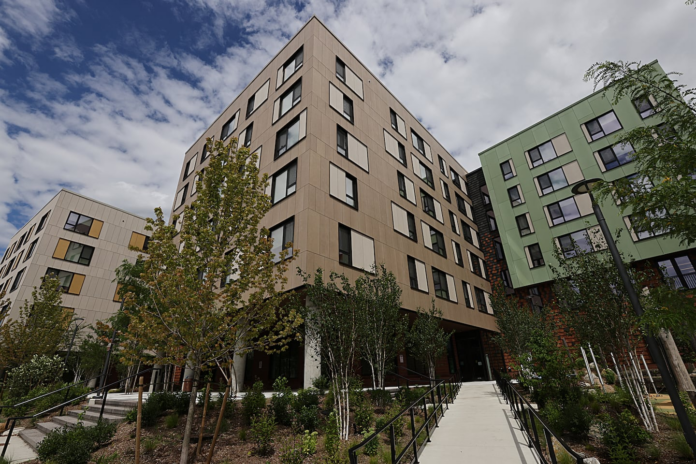Every detail of J.J. Carroll, not quite a year old, is designed for one thing: to help its residents live longer and better, through connection and community. The project reflects a growing movement loosely termed “wellness architecture,” predicated on the belief that a building has profound impacts — whether physical or psychological — on the people that use it. And here, in a seniors housing community, the movement’s precepts could hardly carry more weight.
Inside J.J. Carroll House, an affordable housing development for seniors, a huge barrel-shaped skylight floods a broad expanse of foyer with natural light. Just off the entrance, a glass wall leaves visible the offices of Element Care, a health center where residents can get routine medical attention without leaving the building. Past the reception area, a bank of mailboxes in rich, dark wood sits open to the daylit foyer, turning a utilitarian pickup depot into a natural gathering space.
Countless studies have shown the negative effects of loneliness on seniors; chronic isolation can be associated with everything from depression and anxiety to cognitive impairment and cardiovascular disease. Both times that he served as US Surgeon General, during the Obama and the Biden administrations, Vivek Murthy declared loneliness and social disconnection a health emergency.
In 2019, when the Boston Housing Authority chose 2Life Communities to make a tear-down redevelopment of its aging J.J. Carroll Apartments, the mandate seemed clear. The project would replace a grim, outmoded public housing project for seniors built in the 1960s. The old format, squat brick townhouses made to mimic the scale of the adjacent neighborhood, held 62 units, a scant number in an escalating housing crisis throughout Greater Boston.
Along with making room for more people to live at J.J. Carroll, 2Life was determined to help them live better. The housing nonprofit hired MASS Design Group, the Boston-based architectural firm likely best known around here for collaborating with the artist Hank Willis Thomas on the city’s memorial plaza and sculpture to Coretta Scott King and Martin Luther King Jr. on Boston Common. But housing, health, and how the two intersect, has been the firm’s deeper internal mandate for years. (The MASS part of the firm’s name stands for Model of Architecture Serving Society.)
Advertisement
One of the common spaces in the J.J. Carroll House in Brighton. Suzanne Kreiter/Globe Staff
On the same patch of land, the new J.J. Carroll, completed last year, more than doubles its former units to 142, all designated affordable. The 1.9-acre complex of one- and two- bedroom units snapped into place amid the almost 11-acre larger senior housing campus that surrounds it, which 2Life has built in stages since the 1980s.
In MASS’s redo, a simple, vital ethos of community reigns. “[We thought], ‘How can we provide more opportunities for programming, for services, for social connection, for more meaningful connections to the neighborhood?’,” said Jonathan Evans, MASS’s lead architect on the project. “So you’ll see a lot of courtyards and open space. It’s really intended to be as much of a neighborhood asset as it is social housing.”
Architect Jonathan Evans of MASS Design and Lizbeth Heyer of 2Life Communities at J.J. Carroll House. Suzanne Kreiter/Globe Staff
Public housing is a sensitive realm, given its history. The last time urban housing authorities undertook a major reconfiguration of public housing, in the mid-20th century, it devolved into a disaster of economic and racial segregation. Close-knit neighborhoods were designated as slums and razed; new public housing was often either drably utilitarian row housing — like the kind the new J.J. Carroll replaced — or, in more urban settings, hyperdense towers that packed low-income residents into inhumanely close quarters. The most infamous of them, the Robert Taylor Homes in Chicago, became an emblem of that failed experiment. A haven for crime and gang activity for decades, they were finallly demolished in 2005, to no one’s regret.
Recent years have seen the rise of a more enlightened approach, and Mass Design has been at its forefront. “One big trend in housing for older adults in particular is the integration of services that support health, whether that means service coordination, or care coordination, or just understanding that isolation can be very unhealthy,” said Jennifer H. Molinsky, director of the Housing and Aging Society Program at Harvard’s Joint Center for Housing Studies. “On the other side is the more architectural approach, which asks the question: What is housing that promotes health? Even before this recent trend, MASS has been a leader in this — thinking about opportunities to exercise as you’re walking down the hall, putting a few steps in here, or using a ramp if you want to. You’re encouraged to do those kinds of things.”
Advertisement
A view of the squat, cramped brick row houses that the new development replaced. MASS Design Group
At J.J. Carroll, distinct volumes of building flow smoothly into a coherent whole; it bundles rectilinear forms together — no gratuitous arcs or swoops — but remains thoughtfully variable, like the streetwall of an organic cityscape. A half-dozen stories tall, it slips seamlessly into the urban fabric, set at an angle from the street and broken down into blocks of deliberately soothing logic.
Past the entryway, floor to ceiling windows along a broad Main Street–like corridor flood a cluster of shops — a hair salon, a consignment shop — with natural light. One large space here, with a wall of windows looking onto Chestnut Hill Avenue, was conceived as a flexible area for resident and community-led programming. Lizbeth Heyer, 2Life’s president, suggested it might be a temporary art gallery for residents’ work, or a pop-up retail space, or a room for classes.
In the five upper levels, apartments are arrayed around gathering spaces, with large windows front and back, that encourage activity and bring residents together. When I was there, one space was occupied by a bank of rowing machines.
Advertisement
“If you think about an apartment building, you typically have a corridor building, single or double loaded,” Evans said, evoking every windowless hallway lined with blank doors you’ve ever seen. “We thought, ‘How can we take that and break it down into smaller scales, clusters, and plug them into common spaces?’ That became kind of a catalyst for the design — how do we make those ideas into a building? We ended up with what we call neighborhoods, and this is what’s really exciting here. We’re trying to create housing that helps people live better, longer.”
A courtyard deck and garden ringed with apartments helps give residents a sense of community and inclusion. MASS Design Group
Five neighborhoods, as Evans called them, are bridged by social spaces in between.
“Our goal is to have people be able to be here as long as possible,” living independently, Denise Hamilton, who was 2Life’s executive director of the entire Brighton complex when I visited late last year. “This idea of neighborhoods is literally brilliant — it surrounds them with supportive friends, and helps make that possible.”
From some upper-story apartment windows, residents can look down on a courtyard deck and see rows of big wooden planters forming a grid of community garden. It’s an invitation for anyone who wants it, and a reminder that a community surrounds them.
Molinsky recalled working with MASS Design during the pandemic, puzzling out how a building could help its residents maintain a sense of belonging, even amid a public health emergency that demanded isolation. “You want to have public space, but you also want to have the semi-private and the private with sight lines open to them,” she said. “It was very important that people be able to see their neighbors — ‘Oh, somebody’s in the courtyard, I want to go out and join them.’”
Advertisement
From its bright and capacious gathering spaces to the sensitivity of its presence on the streetscape, everything about J.J. Carroll is designed to welcome. The old J.J. Carroll perched above a retaining wall that barricaded it from the sidewalk. The new one slips into the streetscape with a soft buffer of trees and other plantings that allows filtered views from both sides. Benches and at least one playground, open to passersby, make clear that the building means to be a good neighbor and help foster a healthy, inclusive neighborhood
Within all of it is a much larger goal, and an example to follow. “Massachusetts is one of the most innovative in the country in terms of reaffirming the need for affordable housing and finding every possible way to make it happen,” Evans said. “For us, it becomes: ‘How do we then take that, and design it to do more? What I love is we’re trying to make buildings that affirm the place of affordable housing in a neighborhood. It’s about using design to help establish a sense of dignity.”
Murray Whyte can be reached at murray.whyte@globe.com. Follow him @TheMurrayWhyte.




